Pond placement can make or break the experience of a backyard feature. A well-located pond becomes a focal point that provides visual delight and a soothing atmosphere. Goals often include relaxation, visual interest, or creating a haven for aquatic life.
Define Your Vision and Needs
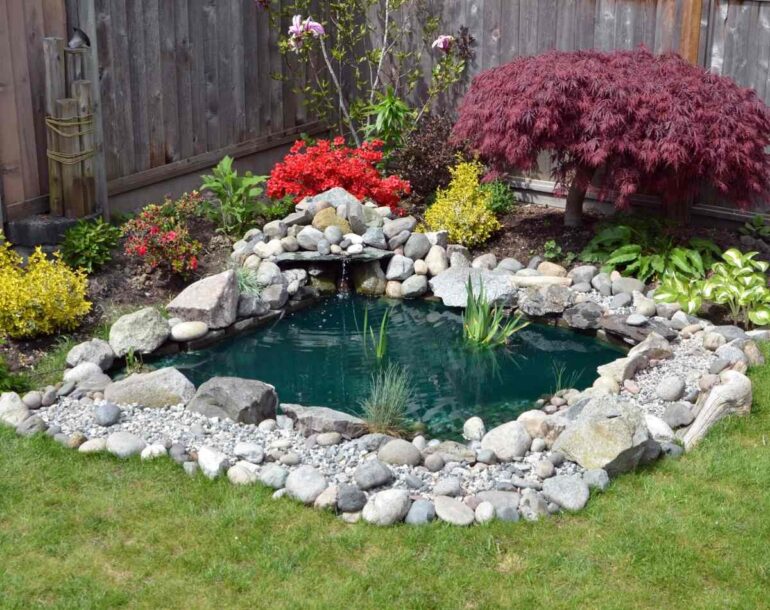
Begin with a clear sense of what the pond should bring to your space. Clarity in purpose sets the stage for every design decision. A tranquil corner for meditation might emphasize calm water, gentle ripples, and minimal movement.
In contrast, a lively water garden with vibrant aquatic plants and fluttering dragonflies leans into:
- Color
- Texture
- Ecological activity
A pond created to house koi demands specific conditions to keep the fish healthy and active. Each intention leads to different design needs.
Ask yourself how often the pond will be viewed and from which angles. Will it become a central feature visible through large windows or next to a patio where guests frequently gather? Or will it remain hidden, tucked away between trees, acting as a private sanctuary? Placement influences layout, materials, and visual rhythm.
To help guide your planning, list your top goals clearly:
- Still water, shade, and quiet placement away from traffic or high footpaths.
- Broad surface area for floating plants, adequate sun exposure, and gentle water circulation.
- Minimum 3-foot depth, strong biological filtration, open design to reduce debris.
- Native plants, shallow edges, and soft transitions into surrounding habitat zones.
- Proximity to seating, dramatic lighting, and integrated sound through fountains or small waterfalls.
Consider functional and decorative features that match your goals. These might include:
- Waterfalls or streams for motion and sound
- Bridges or stepping stones for interactivity
- Lighting for nighttime ambiance and safety
- Benches or pergolas for restful observation spots
Visibility and Accessibility
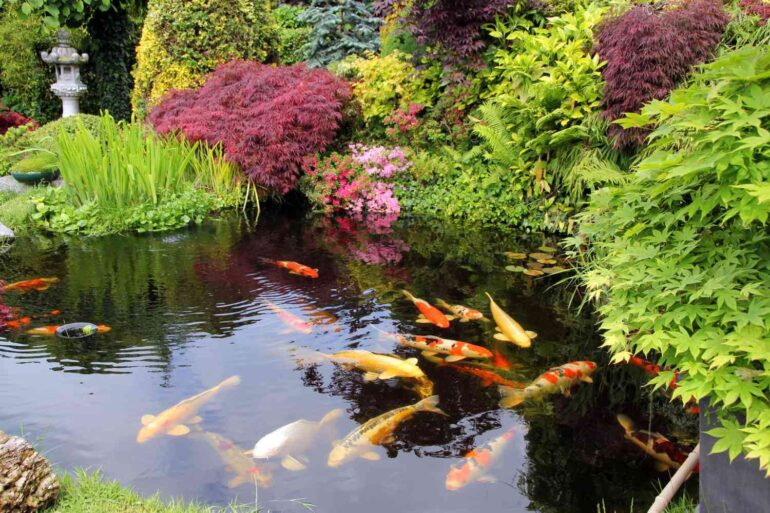
A pond should become part of daily life, not just a forgotten feature tucked in the corner of the yard. Placement in line of sight from high-use areas like the kitchen, family room, or patio keeps it present throughout the day. Watching fish glide through the water while sipping morning coffee or preparing meals adds value to everyday moments. Strategic placement also encourages regular interaction and relaxation.
Several ideal viewing spots can elevate a pond’s presence:
- Kitchen windows for consistent visibility during daily routines
- Living rooms or family rooms where guests and family can admire it
- Outdoor patios or decks for enjoying the pond during gatherings or quiet evenings
Accessibility plays a huge role in how often and easily the pond is maintained. A beautiful design means little if cleaning filters or trimming aquatic plants becomes a burden. Walking through thick brush, climbing slopes, or navigating muddy paths turns quick tasks into frustrating chores. Proper placement helps avoid that by keeping the pond within easy reach.
To simplify access and enhance safety, especially in households with children or older adults, consider these design choices:
- Flat, stable ground that supports movement around the pond
- Paved walkways or stepping stones for easy access during all seasons
- Non-slip surfaces to reduce risk in wet conditions
- Open spaces around the perimeter for tools, hoses, or garden benches
An accessible and visible pond also invites more consistent care. When placed in a well-trafficked area, subtle issues like water cloudiness, algae buildup, or malfunctioning pumps are noticed earlier and handled before they escalate.
Convenience ensures that enjoyment never comes at the expense of effort.
For instance, tools like professional aqua blowers for ponds can aid in clearing out debris and improving circulation in hard-to-reach corners, making routine upkeep simpler and more effective.
Sunlight vs. Shade
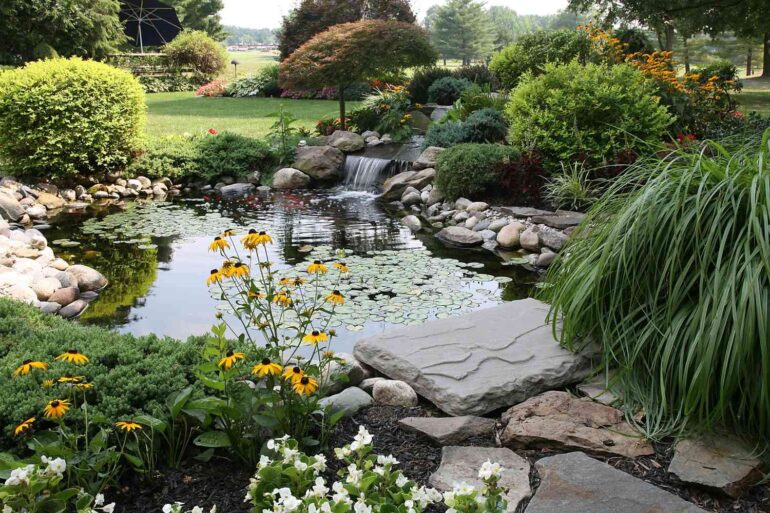
Balancing light exposure is one of the most critical decisions in pond planning. A steady supply of sunlight plays an essential role in sustaining aquatic plant health and maintaining a stable environment for fish.
Most flowering plants, particularly showy varieties like waterlilies, require a minimum of four to six hours of direct sunlight daily to bloom and remain vigorous. Sunlight also helps stabilize water temperature, which benefits both aquatic life and beneficial bacteria.
For ponds that aim to support a variety of plants, light exposure should be analyzed at different times of day and during various seasons. A pond located under partial tree cover or near tall buildings might experience inconsistent light, which will affect growth.
Some oxygenating or foliage-only aquatic plants do tolerate partial shade, though at the cost of slower development and less visual impact.
Here are key light considerations to evaluate before selecting a location:
- 4–6 hours daily for healthy growth of waterlilies and most aquatic flowers
- Suitable for some hardy non-flowering plants such as hornwort or anacharis
- Ensures water stays warm enough to support fish activity and natural bacteria cycles
- Watch for shifts in light availability due to leaf growth in spring or sun angle in fall
A common misconception is that more sun always leads to algae growth. That’s not accurate. Algae blooms are more commonly tied to nutrient overload, such as excess fish waste or decomposing organic matter, combined with poor filtration. Sunlight alone won’t trigger uncontrollable algae if the ecosystem remains balanced.
Avoid Problem Areas
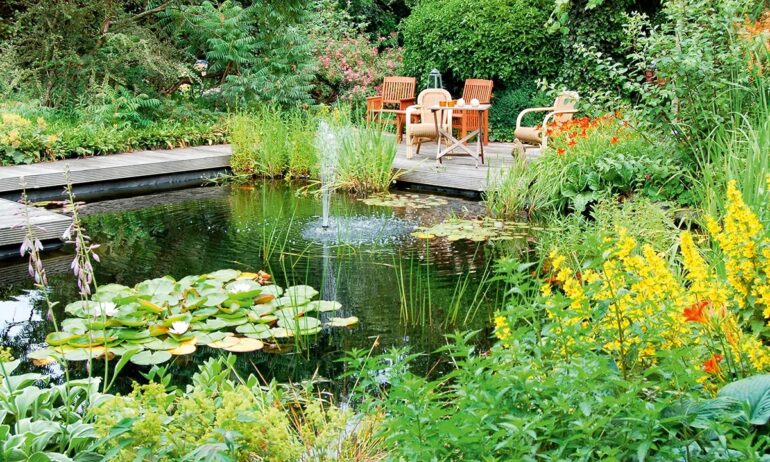
Poor site selection often results in long-term frustration and higher maintenance. An area might look picturesque at first glance, but hidden risks can disrupt pond function and health over time. Overhanging trees are a frequent source of trouble. Branches that hover above the water will inevitably shed leaves, twigs, and pollen. These materials clog filters, reduce oxygen levels, and create sludge buildup on the pond floor.
In some cases, leaves from specific species, such as oak, yew, or black walnut, release tannins and toxins that can discolor the water or harm fish and plant life.
Root systems can be just as problematic. Trees with aggressive roots like willow, bamboo, poplar, or silver maple, constantly seek out moisture. Once a pond is in place, its water becomes a natural magnet for these roots.
Over time, they can puncture liners, lift edging stones, or cause structural failure around the pond. Repairing damage caused by invasive roots often requires complete reconstruction, which is expensive and time-consuming.
Low-lying areas might seem ideal due to their natural basin shape, but such locations often collect surface runoff. After heavy rainfall, water flows into these depressions, carrying lawn chemicals, dirt, mulch, and debris. The result is murky, nutrient-rich water prone to algae blooms and water quality issues. Additionally, poor drainage increases the risk of pond overflow and surrounding soil erosion.
High water tables present another hazard. Digging in these areas may reveal saturated soil that makes excavation unstable. Once the liner is installed, water pressure below can lift or shift it, creating leaks or uneven depths. Building a pond in such a spot can also lead to flooding during seasonal rains.
Safety and Structural Integrity
Safety demands attention during every stage of pond planning, especially when selecting its location. Proximity to home foundations, basements, or retaining walls presents a significant risk. Over time, water pressure and gradual seepage can undermine building stability, leading to costly repairs. A buffer zone of several feet between the pond and any structural element helps reduce potential hazards.
Drainage patterns in your yard must also be taken seriously. During heavy rain, poorly drained soil can turn soft and unstable. Excavating in such areas may result in collapsing sides, uneven settling, or future sinkage.
A level site with firm, compacted soil provides a much more stable base for construction. Sloped areas may still work if proper terracing or retaining features are added, but they require additional engineering. Soil testing, although often skipped, can be valuable. Sandy or silty ground might lack the strength to support larger pond volumes, while clay-heavy soil may retain water too well and cause swelling.
In addition, frost lines matter in colder regions, shallow foundations can crack under winter expansion and contraction if not properly reinforced. Barriers around the pond should not be an afterthought. Pet owners and parents must plan for fences, edge treatments, or shallow safety shelves to reduce the risk of accidents. Lighting near the pond also enhances night visibility and prevents slips or missteps. When ponds reach over two feet in depth, signage or childproof gates become wise additions.
Size and Shape Considerations
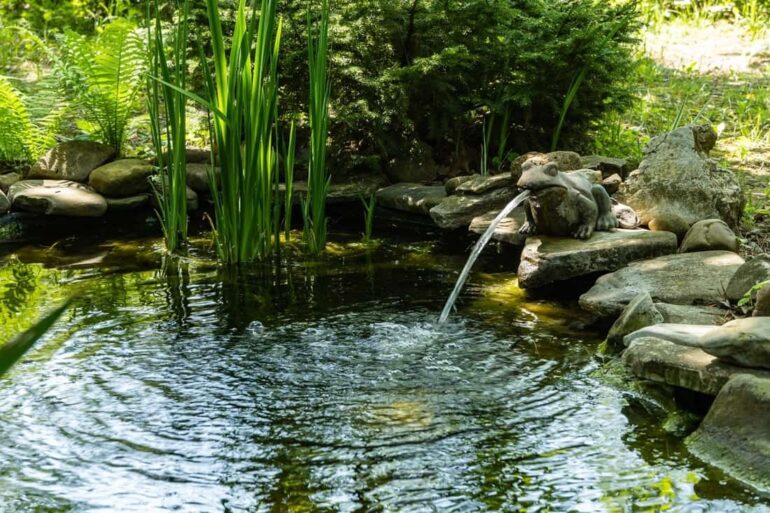
Pond size plays a significant role in long-term maintenance, water quality, and habitat stability. Larger ponds tend to be easier to manage over time.
Water volume in bigger ponds acts as a buffer, making sudden shifts in temperature or pH less likely. In contrast, smaller, shallow ponds are more susceptible to rapid changes that can harm fish, plants, and beneficial bacteria. Shallow water heats up quickly during summer and freezes faster in winter, leading to greater seasonal stress.
Increased surface area with more volume allows a healthier ecosystem to develop, supporting a greater number of fish and more resilient plant growth.
Key benefits of larger ponds include:
- More stable water temperature and chemistry
- Increased oxygen levels to support aquatic life
- Greater resistance to evaporation and algae blooms
- Room for larger or more active fish species
- Broader planting zones with varied depths
Shape also plays a major role in both aesthetics and installation.
While irregular shapes create visual interest and mimic natural water bodies, they can complicate construction and liner fitting. Preformed liners are ideal for standard shapes but restrict flexibility. Flexible liners accommodate creative layouts and work better on uneven or custom-dug areas.
Summary
Proper pond placement turns a basic feature into a lasting source of joy. Placement influences maintenance, aesthetic impact, and environmental health. Take the time to choose wisely and create a space that enhances the backyard in every season. With planning and care, a pond becomes more than decoration, it becomes part of daily life.
